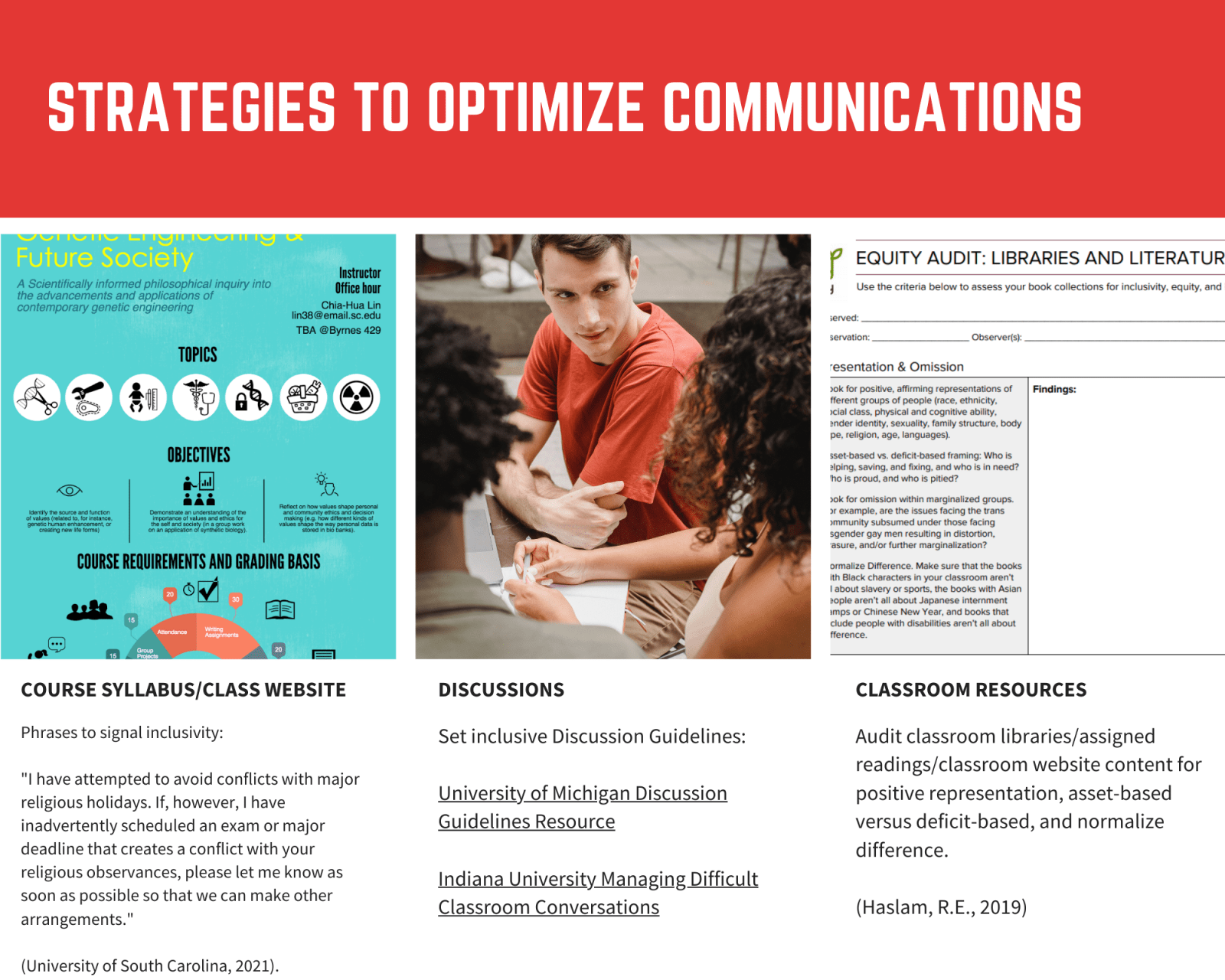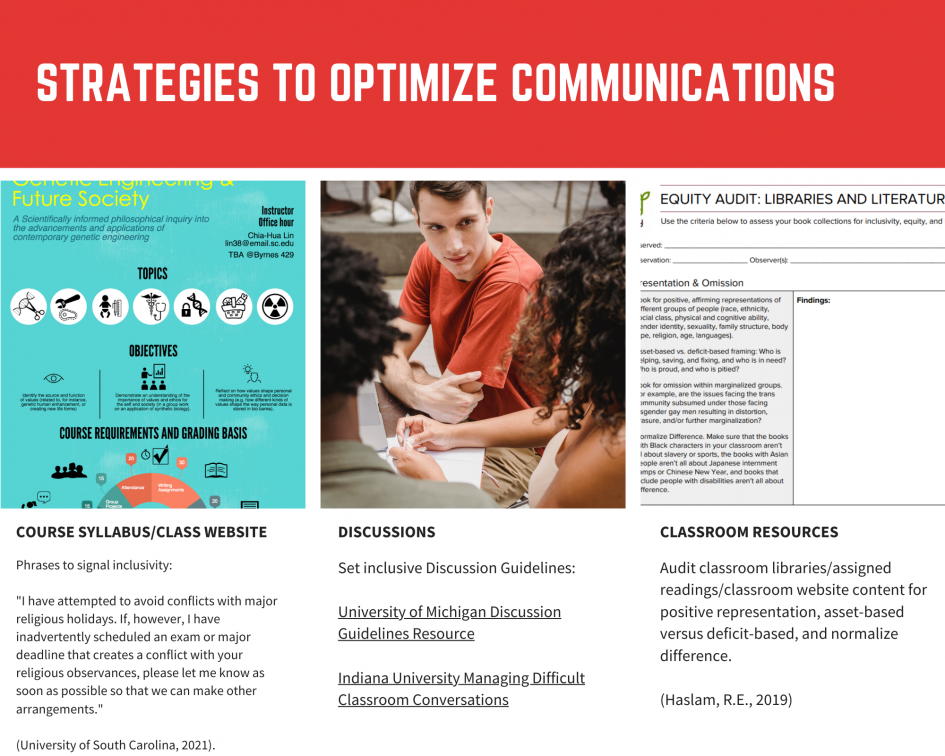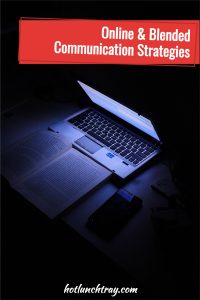The structure of learning environments is within the control of the adults crafting the classroom experience. Recently classroom environments have been online and face-to-face; both modalities can enjoy the same structure to include more students and more points of view. Consider the three communication strategies to demonstrate a dedication to diversity.

Communication Strategies
Lim and Able-Boone (2005) conclude classrooms have the responsibility to prepare students for the academic and the social world. In order to accomplish such student preparation, educators must construct and carry out learning in classrooms intentionally incorporating inclusive messages and addressing areas of institutional inequity. Following are three strategies for communicating those intentions over which the instructor has direct control.
Syllabus or Class Website
The syllabus, or the class website, sets the tone for the learning which will take place in the classroom, face-to-face, or online. A respectful environment includes appropriate behaviors, respect for all stakeholders, and clear expectations (Miller & Pedro, 2006). Functioning as a preview of an upcoming course, advertising the inclusion and tolerance in advance of classroom meetings can intentionally signal the teacher’s intention to be inclusive and honor differences in class.
The infographic syllabus may be adopted for the early childhood grades and use representation to show the inclusion of a variety of family, ethnic, and religious families using fewer words and more pictures (Weinberg, 2019). A document with primary images may be accompanied by situation-specific phrases from the Center for Teaching Excellence (University of South Carolina, 2021). The language used may also signal inclusion.
Discussions
Early childhood learners are not likely to hold opinions as fully formed as educators themselves, however, opinions expressed may indicate the opinions of their caretakers. Trust is the ingredient to build in families, children, and educators in order to conduct safe and inclusive discussions (Puig, et al., 2015). Educators should set boundaries early in classroom discussions by modifying the phrases of Haslam (2019) for early childhood learners and regularly communicate the topics for classroom discussion to families.
Resources from the University of Indiana (2021) and the University of Michigan (2021) may prepare educators for potential topics and appropriate responses. Increasingly open discussions which educators may not have seen modeled in their early elementary experiences may need to be role-played with other teachers in advance of inclusion in the classroom. School leadership and counselors may be beneficial to include in any initial changes to this practice.
Classroom Resources
Haslam (2020) set criteria on which to edit classroom resources and libraries. This could be accomplished by a grade-level team or specialists. As a result of this inventory, the least beneficial books may be removed from circulation, but more importantly, a list of future purchases can be created. Future books can be contributed by families as well as purchased by the school or teacher. A list that identifies future categories desired: holidays to represent, family structures to include, learning differences, asset-based versus deficit-based, places, traditions, customs can all signal the intention to build a more inclusive classroom.
Conclusion
A change in the classroom or school outlook may be necessary to accomplish a shift in including more stakeholders in classrooms in a positive manner. Leadership needs to share the purpose and structure any extra practice or supports educators may need for this shift. While time to dialogue through scenarios may be the primary need, consider future purchases and how to direct budgets in the future to sustain any such shift.
References
Center for Research on Learning and Teaching, University of Michigan. (2021). Setting the Tone for Inclusive Classrooms. Inclusive Teaching. https://sites.lsa.umich.edu/inclusive-teaching/inclusive-classrooms/setting-the-tone-for-inclusive-classrooms/.
Center for Teaching Excellence. University of South Carolina. (2021). Tools & Resources. https://sc.edu/about/offices_and_divisions/cte/teaching_resources/syllabus_templates/syllabus_statement_examples/index.php.
Lim, C.-I., & Able-Boone, H. (2005). Diversity competencies within early childhood teacher preparation: Innovative practices and future directions. Journal of Early Childhood Teacher Education, 26(3), 225–238. https://doi.org/10.1080/10901020500369803
Haslam, R.E. (2019). Interrupting bias: Calling out vs. calling in. Seed the Way LLC. http://www.seedtheway.com/uploads/8/8/0/0/8800499/calling_in_calling_out__3_.pdf
Haslam, R. E. (2020). Equity Audit: Literature and Libraries. Seed the Way LLC. http://www.seedtheway.com/uploads/8/8/0/0/8800499/equity_audit__libraries_and_literature__rev.dec20_.pdf
Managing Difficult Classroom Discussions. (2021). Center for Innovative Teaching and Learning. https://citl.indiana.edu/teaching-resources/diversity-inclusion/managing-difficult-classroom-discussions/index.html.
Miller, R., & Pedro, J. (2006). Creating respectful classroom environments. Early Childhood Education Journal, 33(5), 293–299. https://doi.org/10.1007/s10643-006-0091-1
Puig, V. I., Erwin, E. J., Evenson, T. L., & Beresford, M. (2015). “It’s a Two-Way Street”: Examining How Trust, Diversity, and Contradiction Influence a Sense of Community. Journal of Research in Childhood Education, 29(2), 187–201. https://doi.org/10.1080/02568543.2015.1009588
Weinberg, J. (2019, February 25). Philosophy Syllabus as Infographic. Daily Nous. https://dailynous.com/2017/01/19/philosophy-syllabus-infographic/.







1 Pingback